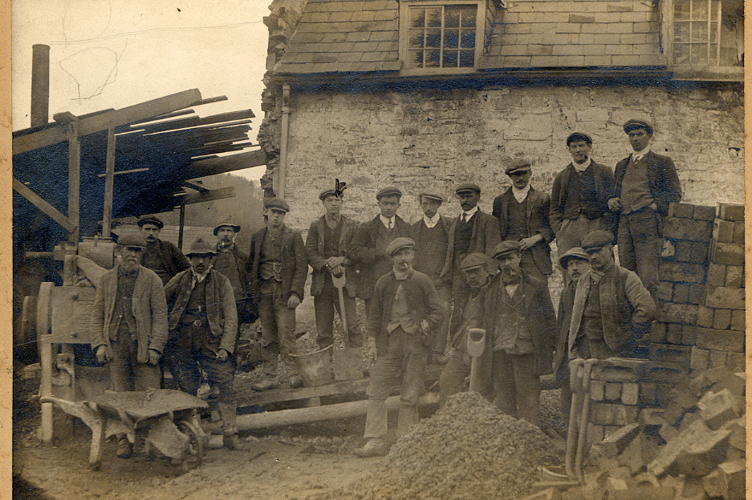The Brecknock Museum photograph collection in y Gaer contains a wealth of information about Brecon and the surrounding area.
“The photos are a record of continuity and of change, providing valuable insights into the social and economic history of our area,” said Collections Assistant Jacquie Morgan.
“Here are some examples which show some familiar places and activities over the years, with construction and repair as continuing themes.”
The photo of St David’s Church in Llanfaes shows it in the very early 1900s.

In 1903 there were vestry meetings chaired by David Evans of Ffrwdgrech to discuss building a new church in Llanfaes as St David’s was too small (with a capacity of 260) for the population that it served. A site opposite the current church was proposed, but this came to nothing and by 1906 the annual vestry meeting agreed “the tower would have to be seen to sooner or later. It wanted pointing … for the water came through” (Brecon County Times 20th April 1906.) This is probably the work being carried out in the photo. The names Phil Williams, Dick Powler, and Fred Walters are written on the back of the photo, likely identifying three of the four workmen shown, and the scaffolding was erected by A. James. St David’s was eventually enlarged in 1923-25.
Also from the early 1900s we have a photo of a mortar mixer and a photo of a group of workmen at a construction site. The mortar mixer is a stationary machine (a mobile mortar mixer, like a modern concrete mixer, was only patented by Richard Bodlaender of Breslau in 1904). Hand tools include shovels and spades similar to modern tools, and wheelbarrows of a recognisable design but with solid wheels rather than pneumatic tyres. Clothing is typical of the time, including waistcoats and ties, and some men are smoking pipes.


Another photo from circa 1900 shows workmen constructing a road.
“The topography suggests this is the route of the current A40 east of Bwlch, with the camera looking eastwards,” said Jacquie.
“Spades, shovels, brooms, and horse-drawn carts are joined by a steam roller. We can tell this is an Aveling and Porter steam roller from the company’s rampant horse logo on the front of the engine. Based in Kent, Aveling and Porter developed their steam engine in 1865 and by the early 1900s were the largest manufacturer of steam rollers in the world. Their logo is derived from the White Horse of Kent.”
A photo from 1947 shows 22 workmen at Gwernyfed House during its conversion to a school. The Jacobean style window is clearly identifiable as part of the 19th century Gwernyfed Hall. Front row, second left is Dennis Perkins.

“Do any readers recognise any other men in this photo?” asked Jacquie.
“The photograph collection is also a reminder of how photographic trends have changed,” Jacquie continued.
“We have proportionately far more photographic evidence from the nineteenth and twentieth centuries than we do from the 21st century. That’s a reflection of how photos are now usually stored digitally on devices now rather than printed out. The days of printing photos and keeping them in physical photo albums have largely gone. We continue to add to our photographic collection, to preserve vital evidence about our town and county for the future. People’s kindness in donating photos (whether printed or digital) to our collection at y Gaer enables us to record more recent continuity and change in our area.”
If you remember anyone in these photographs or have any related information or photos that you’d be happy to share with us, Jacquie would be delighted to hear from you.
Contact us on 01874 624121 or at [email protected] (FAO Jacquie Morgan)




